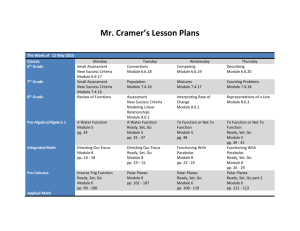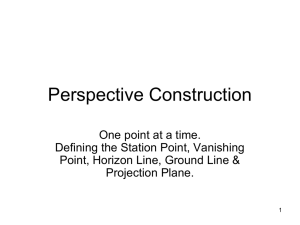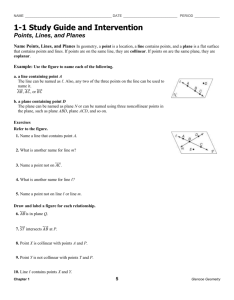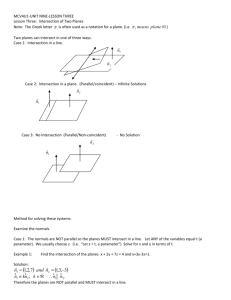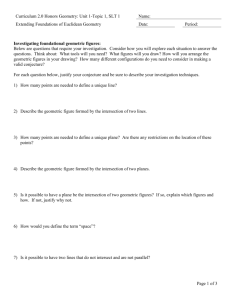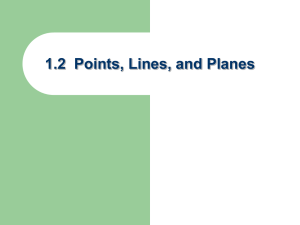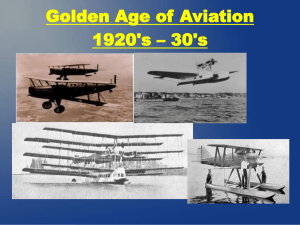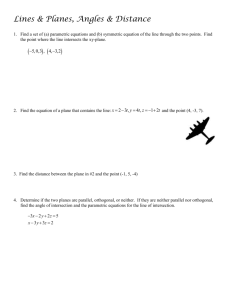DOC - EduGAINS
advertisement
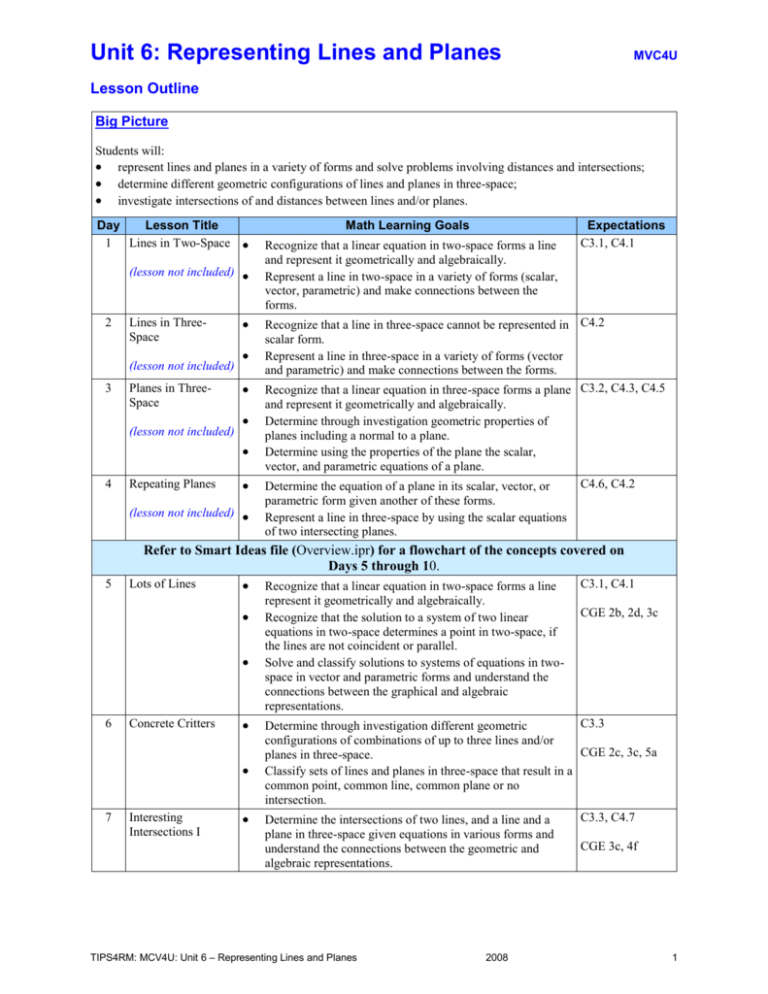
Unit 6: Representing Lines and Planes MVC4U Lesson Outline Big Picture Students will: represent lines and planes in a variety of forms and solve problems involving distances and intersections; determine different geometric configurations of lines and planes in three-space; investigate intersections of and distances between lines and/or planes. Day Lesson Title 1 Lines in Two-Space (lesson not included) 2 Lines in ThreeSpace (lesson not included) 3 Planes in ThreeSpace (lesson not included) 4 Repeating Planes (lesson not included) 5 Concrete Critters 7 Recognize that a linear equation in two-space forms a line and represent it geometrically and algebraically. Represent a line in two-space in a variety of forms (scalar, vector, parametric) and make connections between the forms. Expectations C3.1, C4.1 Recognize that a line in three-space cannot be represented in C4.2 scalar form. Represent a line in three-space in a variety of forms (vector and parametric) and make connections between the forms. Recognize that a linear equation in three-space forms a plane C3.2, C4.3, C4.5 and represent it geometrically and algebraically. Determine through investigation geometric properties of planes including a normal to a plane. Determine using the properties of the plane the scalar, vector, and parametric equations of a plane. C4.6, C4.2 Determine the equation of a plane in its scalar, vector, or parametric form given another of these forms. Represent a line in three-space by using the scalar equations of two intersecting planes. Refer to Smart Ideas file (Overview.ipr) for a flowchart of the concepts covered on Days 5 through 10. Lots of Lines C3.1, C4.1 Recognize that a linear equation in two-space forms a line 6 Math Learning Goals Interesting Intersections I represent it geometrically and algebraically. Recognize that the solution to a system of two linear equations in two-space determines a point in two-space, if the lines are not coincident or parallel. Solve and classify solutions to systems of equations in twospace in vector and parametric forms and understand the connections between the graphical and algebraic representations. CGE 2b, 2d, 3c C3.3 Determine through investigation different geometric configurations of combinations of up to three lines and/or CGE 2c, 3c, 5a planes in three-space. Classify sets of lines and planes in three-space that result in a common point, common line, common plane or no intersection. C3.3, C4.7 Determine the intersections of two lines, and a line and a plane in three-space given equations in various forms and CGE 3c, 4f understand the connections between the geometric and algebraic representations. TIPS4RM: MCV4U: Unit 6 – Representing Lines and Planes 2008 1 Day Lesson Title 8 Interesting Intersections II 9 Interesting Intersections III Presentation Software file: Intersection of 3 PLanes 10 Math Learning Goals How Far Can It Be? Expectations C3.3, C4.3, C4.4, Determine the intersections in three-space of two planes and C4.7 three planes intersecting in a unique point given equations in various forms and understand the connections between the CGE 3c, 4f graphical and algebraic representations of the intersection. C4.4, C4.7 Determine the intersections of three planes in three-space given equations in various forms and understand the CGE 2b, 2d, 3c connections between the graphical and algebraic representation of the intersection. Recognize that if a b c 0 is true then the three planes intersect at a point. Solve problems involving the intersection of lines and planes in three-space represented in a variety of ways. C3.3, C4.3, C4.7 Calculate the distance in three-space between lines and planes with no intersection. Solve problems related to lines and planes in three-space that CGE 2b, 2d, 3c are represented in a variety of ways involving intersections. 11 Jazz Day 12– Summative 14 Assessment Units 5 and 6 TIPS4RM: MCV4U: Unit 6 – Representing Lines and Planes 2008 2 Smart Ideas Files TIPS4RM: MCV4U: Unit 6 – Representing Lines and Planes 2008 3 Unit 6: Day 5: Lots of Lines (L2) MVC4U Math Learning Goals Recognize that a linear equation in two-space forms a line represent it geometrically and algebraically. Recognize that the solution to a system of two linear equations in two-space determines a point in two-space if the lines are not coincident or parallel. Solve and classify solutions to systems of equations in two-space in vector and parametric forms and understand the connections between the graphical and algebraic representations. Materials BLM 6.5.1 chart paper and markers 75 min Assessment Opportunities Minds On… Groups Graffiti Prepare and post nine sheets of chart paper each with a system of two equations (BLM 6.5.1). Each group solves two of the three types of systems and summarizes the third type. Curriculum Expectation /Observation/Mental Note: Observe students’ understanding of the concepts. In heterogeneous groups of three or four (total nine groups), students visit three consecutive stations, working with systems of equations having a unique solution, representing two coincident lines, and representing parallel lines. At the first station, each group solves the system graphically. Then each group moves clockwise one station and solves the system at this station algebraically. Finally, each group moves clockwise one station and by observing and reasoning about the graphical and algebraic work completed, students write a summary of the connections between the algebraic and graphical representations of the system. Refer to Smart Ideas file Overview.ipr for a flowchart of the concepts covered in lessons 5 through 10. See pp. 30–33 of Think Literacy: Cross-Curricular Approaches, Grades 7–12 for more information on graphic organizers. Groups Gallery Walk Groups visit the next three stations to consolidate their findings. Action! Whole Class Discussion Lead a discussion of algebraic solutions of systems of two equations in twospace (scalar and parametric, parametric and parametric, vector and vector). See teacher BLM 6.5.1 for examples. Mathematical Process Focus: Representation – Students represent linear systems in two-space graphically and algebraically. Consolidate Pairs Graphic Organizer Debrief Students summarize the possible solutions resulting from solving systems of equations in 2-D in various forms and the connections between the graphical and the three algebraic representations of systems of two equations in two-space. Practice Home Activity or Further Classroom Consolidation Complete assigned practice questions. TIPS4RM: MCV4U: Unit 6 – Representing Lines and Planes Choose consolidation questions based on observations of need. 2008 4 6.5.1: Systems of Equations in 2-D (Teacher) Minds On… For Graffiti Activity One point 1. Coincident Parallel 2. 2x + y = –1 3x – y = –4 4. 3. 5. 6. 1 x 1 4 2x – 8y = 2 y 3x – y = –10 2x + 3y = 8 7. 2 x2 5x 2x – 5y = 20 y y = 3x – 5 6x – 2y – 10 = 0 y=5 5y – 15 = 0 8. 2x – 3y = 9 3x + 4y = 5 9. x – 2y = 3 2x – 4y – 6 = 0 6x – 2y = 8 y = 3x + 1 Parametric and Parametric Vector and Vector Action! For Teacher-led Instruction Scalar and Parametric L1: x – 2y = 3 t x L2: 3 y 2t L1: x t 2 y = –1 – t TIPS4RM: MCV4U: Unit 6 – Representing Lines and Planes L2: 8 3 y=s+4 x L1: r (1, 2) t (1.3) L2: r (0, 5) s(1, 3) 2008 5 Unit 6: Day 6: Concrete Critters Intersecting Lines and Planes MVC4U Math Learning Goals Determine through investigation different geometric configurations of combinations of up to three lines and/or planes in three-space. Classify sets of lines and planes in three-space that result in a common point, common line, common plane, or no intersection. Materials BLM 6.6.1, 6.6.2, 6.6.3 card stock straws OR pipe cleaners OR wooden skewers 75 min Assessment Opportunities Minds On… Pairs Share Review Curriculum Expectation/Observation/Mental Note: Circulate, listen, and observe for student’s understanding of this concept as they complete BLM 6.5.1. Students coach each other as they complete the solutions to the systems of equations (BLM 6.6.1). A coaches B, and B writes, then reverse. Whole Class Discussion Review three possible solutions from previous day’s intersection of lines in twospace (point of intersection, parallel lines, coincident lines). Invite suggestions on what would be the same/different/new if solving for the intersection of two lines in three-space. Action! For Pair/Share: one handout and one pencil per pair. Teachers may wish to have students work in small groups instead of pairs. Differentiating instruction: Use the graphic organizer to provide scaffolding. Pairs Investigation/Experiment Mathematical Process Focus: Representing Students represent geometrically lines and planes in three-space (BLM 6.6.2). They use concrete materials to model and/or construct as many different possibilities of intersections (or non-intersections) using up to three lines and/or planes. Students describe each possibility briefly and sketch what it looks like BLM 6.6.2. Consolidate Small Groups Graphic Organizer Debrief Students complete their choice of a graphic organizer to summarize the various outcomes of lines and planes that result in a single point of intersection, a line of intersection, a plane, or no common intersection (BLM 6.6.3). Whole Class Summary Share results of investigation and graphic organizer task. Application Home Activity or Further Classroom Consolidation Bring to class the next day interesting visual examples, e.g., photos, newspaper clippings, physical objects, of real-life intersections of lines and planes. TIPS4RM: MCV4U: Unit 6 – Representing Lines and Planes 2008 Consider preparing a visual display of the examples to be used over the next several days. 6 6.6.1: Pair/Share – Don’t Double Cross the Line Instructions A solves question A, B coaches B solves question B, A coaches Question A x = 5s y = 7s (x, y) = (1, 7) + t(3, 7) TIPS4RM: MCV4U: Unit 6 – Representing Lines and Planes Question B (x, y) = (3, 9) + t(2, 5) 2008 (x, y) = (–5, 6) + s(3, –1) 7 6.6.2: Intersection Investigation Use concrete materials to model and/or construct as many different possibilities of intersections (or non-intersections) using up to three lines and/or planes. Make a sketch and describe what it looks like. Combination 2 Lines Sketch and Description(*) * * * * * * * * * * * * * * * * * * * * 3 Lines 1 Line + 1 Plane 2 Planes 3 Planes TIPS4RM: MCV4U: Unit 6 – Representing Lines and Planes 2008 8 6.6.3: Intersection Convention Summarize the various outcomes of lines and planes that result in an intersection of: a single point, a line, a plane, or no common intersection at all. TIPS4RM: MCV4U: Unit 6 – Representing Lines and Planes 2008 9 Unit 6: Day 7: Interesting Intersections – Part 1 MVC4U Math Learning Goals Determine the intersections of two lines, and a line and a plane in three-space, given equations in various forms and understand the connections between the geometric and algebraic representations. Materials BLM 6.7.1, 6.7.2 75 min Assessment Opportunities Minds On… Whole Class Discussion Lead a discussion in which students identify four possible representations of a system of two lines in three-space (one point, coincident, parallel, skew) and three possible representations of a system of a line and a plane in three-space (one point, coincident and parallel). Action! Groups Jig Saw Learning Skills Teamwork/Observation/Rubric/Written Note: Circulate and make note of students’ teamwork performance. Form heterogeneous groups of at least four students per home group. Assign four experts using numbered heads. Students solve systems of two equations in threespace. Use an assortment of parametric and vector forms (BLB 6.7.1). Expert Group 1 solves a system of two lines with one point of intersection and a system of a line parallel to a plane. Expert Group 2 solves a system of two parallel distinct lines and a system of a line that intersects the plane. Expert Group 3 solves a system of two lines coincident lines and a system of a line parallel to a plane. Expert Group 4 solves a system of two skew and a system of a line in the plane. Refer to Smart Ideas™ file Overview.ipr for details of representations. Use the pictures students collected for home extension Day 6 to demonstrate relevant scenarios. If home groups contain more than four students, ensure that the expert groups are equally balanced. Reference the eLearning Ontario “toolkit” for graphing lines and planes in 3-D. Students return to home groups and share and summarize findings using a graphic organizer (BLM 6.7.2). Mathematical Process Focus: Communicating: Students communicate their understanding of the various permutations of systems of equations of two lines and a line and a plane in three-space. Consolidate Whole Class Discussion Debrief Lead a discussion to verify that students understand all possible scenarios of systems of two lines in three-space and of systems of a line and a plane in threespace. Practice Home Activity or Further Classroom Consolidation Complete assigned practice questions. Describe the pictures gathered in the previous lesson according to the types of systems encountered in this lesson. TIPS4RM: MCV4U: Unit 6 – Representing Lines and Planes 2008 Choose consolidation questions based on observations of need. 10 6.7.1: Sample Systems of Equations (Teacher) System of Two Lines Systems of a Line and a Plane Group 1: Solve the following system. ( x, y, z ) ( 5, 2, 7) t (3, 2, 6) x s y 6 5s z 3 s Group 1: Solve the following system. x 5 t y 4 2t z 7 2t 2x 3 y 4z 7 0 t s, t Group 2: Solve the following system. x 1 t x 3 2s y 2t y 4 2s z t z 1 2s Group 2: Solve the following system. ( x, y, z ) ( 4, 6, 2) t ( 1, 2,1) 2 x y 6 z 10 0 t s, t Group 3: Solve the following system. ( x, y, z ) (111 , , ) t (1, 2, 3) ( x, y, z ) (3, 5, 5) s( 2, 4, 6) Group 3: Solve the following system. ( x, y, z ) (2,1, 4) t (1, 0,1) 3x 4 y 3z 9 0 t s, t Group 4: Solve the following system. x 2 s y 1 3s z 7s ( x, y, z ) (3, 3, 4) t (5, 4, 2) Group 4: Solve the following system. x 2t y 4t 3 x y 2z 6 0 t s, t TIPS4RM: MCV4U: Unit 6 – Representing Lines and Planes z 1 t 2008 11 6.7.2: Systems of Two Lines and Systems of a Line and a Plane After each expert has shared in your home group, summarize the findings by completing the following table. The description can be either words or a sketch. System of Two Lines In Three-Space Description Number of Intersection Points TIPS4RM: MCV4U: Unit 6 – Representing Lines and Planes System of a Line and a Plane in Three-Space Description 2008 Number of Intersection Points 12 Unit 6: Day 8: Interesting Intersections – Part 2 MVC4U Materials Math Learning Goals BLM 6.8.1, 6.8.2, Determine the intersections in three-space of two planes and three planes 6.8.3, 6.8.4 intersecting in a unique point given equations in various forms and understand the card stock and connections between the graphical and algebraic representations of the intersection. straws scissors 75 min Assessment Opportunities Minds On… Pairs Exploration Using card stock as models for planes, students predict the three possible solutions for a system of two planes in three-space. Students summarize the information the normal vectors and constants provide for each possible solution type (BLM 6.8.1). This is a consolidation of concepts developed in previous lessons in this unit. Curriculum Expectation/Observation/Oral Feedback: Observe students as they complete BLM 6.8.1 and provide oral feedback, as required. Whole Class Teacher-led Instruction Demonstrate elimination and substitution as methods for solving the systems algebraically (BLM 6.8.1). Help students make the connection between the geometric and algebraic representations: Describe how the algebraic solution indicates whether the planes intersect or not? How do you differentiate algebraically between coincident planes and planes intersecting in a line? Action! Reference the eLearning Ontario “toolkit” for graphing lines and planes in 3-D. The connection to the scalar triple, a b c will be made in the next lesson. Groups Investigation In heterogeneous groups of three or four, students build the model of the system and solve it algebraically, using elimination or substitution (BLMs 6.8.2 and 6.8.3). Mathematical Process Focus: Representing and Connecting Students represent intersection of three planes geometrically and connect the algebraic solution to the geometric model. Consolidate Whole Class Discussion Debrief To make the connection between the geometric and algebraic representation ask: What is the significance of the algebraic representation as it relates to the geometric model? What observations can be made about the normal vectors to the planes in BLM 6.8.3? (Answer: Normal vectors are not scalar multiples or coplanar.) Will these properties be true for all systems of three planes with a unique solution? Journal Entry Home Activity or Further Classroom Consolidation Predict how the relationship among normal vectors to three planes will change for the other geometric scenarios summarized on Worksheet 6.6.3. TIPS4RM: MCV4U: Unit 6 – Representing Lines and Planes 2008 13 6.8.1: Characteristics of Normal Vectors for Intersecting Planes System of Equations 2 x 3 y 2z 5 6 x 9 y 6 z 12 Description Two distinct parallel lines Sketch Intersection Points Analysis Normal vectors are scalar multiples of each other. 0 Constants are not the same multiple of each other. 2 x 13 y 6 z 7 ( x, y , z ) (0, 1,1) s(3, 0,1) t ( 4, 2, 3) x 3 y 6 z 13 x 1 2s 5t y 4s t z 2 s 2t TIPS4RM: MCV4U: Unit 6 – Representing Lines and Planes 2008 14 6.8.2: Intersection of Three Planes Investigation Problem Consider the different ways three planes can intersect and answer the following questions: How is the concrete representation related to the algebraic solution? How are normal vectors used to verify the model? Procedure Part A: Geometric Model 1. Cut out and assemble the set of coloured cards representing planes by matching like letters. Observe and describe the intersection of this geometric model. Make a sketch of your model. 2. Predict how the algebraic solution will indicate this intersection. (Hint: Consider the possible geometric models and corresponding algebraic solutions of two lines in two-space.) 3. Using straws to represent the normal vector to each plane, describe the relationship among the normal vectors using terms such as parallel (collinear), coplanar, or non-coplanar. Part B: Algebraic Model 1. Solve the system algebraically, using the equations of the planes. 2. Does your solution match your prediction from above? How do the normal vectors confirm your prediction model? 3. Summarize the connection between the algebraic solution and the geometric model. TIPS4RM: MCV4U: Unit 6 – Representing Lines and Planes 2008 15 6.8.3: Intersection of Three Planes – Set 1 B A C x + 2y + 3z + 4 = 0 x – y – 3z – 8 = 0 D A E B E 2x + y + 6z + 14 = 0 D TIPS4RM: MCV4U: Unit 6 – Representing Lines and Planes C 2008 16 6.8.4: Intersection of Three Planes: Solutions and Conclusions (Teacher) Set 1 1: x + 2y + 3z + 4 = 0 2: x – y – 3z – 8 = 0 3: 2x + y + 6z + 14 = 0 (1) – (2) 2 (1) – (3) 3y + 6z + 12 = 0 3y – 6 = 0 (1) (2) (3) (4) (5) y=2 substitute into (4) z=–3 substitute into (1) x=1 Conclusions The three planes intersect in the point in space (1, 2, –3) The normal vectors are non coplanar (i.e., form a basis for 3) The scalar triple of the normal vectors, a b c as will be demonstrated in the next lesson. TIPS4RM: MCV4U: Unit 6 – Representing Lines and Planes 2008 17 Unit 6: Day 9: Interesting Intersections – Part 3 MVC4U Math Learning Goals Determine the intersections of three planes in three-space given equations in various forms and understand the connections between the graphical and algebraic representation of the intersection. Recognize that if a b c 0 is true then the three planes intersect at a point. Solve problems involving the intersection of lines and planes in three-space represented in a variety of ways. Materials card stock chart paper and markers BLMs 6.9.1–6.9.5 data projector 75 min Assessment Opportunities Minds On… Groups Placemat Students list/sketch all the possible intersections, or non-intersections, of three planes in three-space in their section of the place mat. As a group, students consolidate and classify their findings and write them in the centre of the placemat. Whole Class Discussion Consolidate group findings, using a graphic organizer. Action! Groups Investigation Curriculum Expectation/Observation/Mental Note: Circulate, listen, and observe student proficiency at determining the intersection of three planes by solving a system of three equations. Intersection of 3 PLanes.ppt Provide groups with three pieces of paper to represent plane intersections. For information on placemats see p. 66 of Think Literacy: Cross-Curricular Approaches, Grades 7–12. In heterogeneous groups of three or four, students build the model of the system and solve it algebraically using elimination or substitution (BLM 6.9.1 and 6.8.2). Students record their finding (BLM 6.9.2). Consolidate Whole Class Discussion Debrief Lead a discussion to consolidate student understanding of the information they recorded. Ask: What does the algebraic solution tell you about the uniqueness of the solution? How can you use normal vectors to distinguish between two different models with similar algebraic solutions? Observe the values of the scalar triple product, a b c. What geometric conclusions about the normal vectors, and subsequently the planes, can be deduced from this calculation? Mathematical Process Focus: Reasoning and Proving: Students use normal vectors to classify the geometric solutions to the various intersections of three planes. Pairs Extension Students complete BLM 6.9.3. Application Use power point file (BLM 6.9.5) to consolidate student understanding of the possible solution types for the intersection of three planes (BLM 6.9.2). Reference the eLearning Ontario “toolkit” for graphing lines and planes in three-spaces Curriculum Expectation/Worksheet/Checkbric: Collect BLM 6.9.3 and assesses student work using a checkbric. Assessment as learning to allow students to check their understanding. Home Activity or Further Classroom Consolidation Extend your collections of visual examples of combinations of points, lines and planes that have a finite distance between them. Select appropriate questions for practice TIPS4RM: MCV4U: Unit 6 – Representing Lines and Planes 2008 18 6.9.1: Intersection of Three Planes – Set 2 A B C x + 2y + 3z + 4 = 0 x – y – 3z – 8 = 0 x + 5y + 9z + 10 = 0 TIPS4RM: MCV4U: Unit 6 – Representing Lines and Planes 2008 B C A 19 6.9.1: Intersection of Three Planes – Set 3 A B x + 2y + 3z + 4 = 0 A x + 3y + 2z + 3 = 0 B 2x + 6y + 4z – 7 = 0 TIPS4RM: MCV4U: Unit 6 – Representing Lines and Planes 2008 20 6.9.1: Intersection of Three Planes – Set 4 A x + 2y + 3z + 4 =0 A x – y – 3z – 8 = 0 B B x + 5y + 9z + 16 = 0 1616===00 TIPS4RM: MCV4U: Unit 6 – Representing Lines and Planes 2008 21 6.9.2: Characteristics of Normal Vectors for Intersecting Planes Record the information found from the investigation on BLM 6.8.2. System of Equations Description Sketch Solution Additional Information Normal vectors: a (1, 2, 3) b (1, 1, 3) c (2,1, 6) Set 1: x 2 y 3z 4 0 x y 3z 8 0 2 x y 6 z 14 0 Three planes intersection in a point. (1, 2, –3) a b c 18 Set 2: Set 3: Set 4: Graphic source: www.rwgrayprojects.com/Lynn/iop/iop.html TIPS4RM: MCV4U: Unit 6 – Representing Lines and Planes 2008 22 6.9.3: Connecting Algebraic and Geometric Models of the Intersection of Three Planes 1. List and sketch any other configuration of three planes which you have not modelled in the investigation 6.9.2. a bc a bc a bc a bc 2. If you solved the system of equations that are represented by these planes, what is the nature of solution would you expect? 3. How would you use normal vectors to identify the configuration? 4. a) Explain how, and in which models, the scalar triple product a b c of normal vectors is helpful? b) Record the value of the scalar triple product, a b c , for each case above. TIPS4RM: MCV4U: Unit 6 – Representing Lines and Planes 2008 23 6.9.4: Intersection of Three Planes: Solutions and Conclusions (Teacher) Set 2 1: 2: 3: (1) – (2) (1) – (3) (4) + (5) (1) (2) (3) x + 2y + 3z + 4 = 0 x – y – 3z – 8 = 0 x + 5y + 9z + 10 = 0 3y + 6z + 12 = 0 –3y – 6z – 6 = 0 6=0 no solution (4) (5) contradiction no intersection Conclusions a) normal vectors are not scalar multiples no parallel planes b) scalar triple product is zero normal vectors are coplanar (and no solution) planes form a triangular prism in space Set 3 1: x + 2y + 3z + 4 = 0 2: x + 3y + 2z + 3 = 0 3: 2x + 6y + 4z – 7 = 0 2 (2) – (3) results in: (1) (2) (3) 13 = 0 a contradiction no solution no intersection Conclusions a) 2 and 3 have parallel normal vectors BUT are not merely multiples of the same plane parallel planes TIPS4RM: MCV4U: Unit 6 – Representing Lines and Planes 2008 24 6.9.4: Intersection of Three Planes: Solutions and Conclusions (Teacher) (continued) Set 4 1: x + 2y + 3z + 4 = 0 2: x – y – 3z – 8 = 0 3: x + 5y + 9z + 16 = 0 (1) – (2) (1) – (3) (4) + (5) 3y + 6z + 12 = 0 –3y – 6z – 12 = 0 0=0 Consider (4): If z = t then and (1) (2) (3) (4) (5) always true, (always a solution) solution exists but not unique y = –2z – 4 y = –2t – 4 x + 2(–2t – 4) + 3t + 4 = 0 x=t+4 i.e.,(x, y, z) = (t + 4, –2t – 4, t), a line in space Conclusions a) and b) as in Set 2 c) Comparing the equations to Set 1, 3 has been translated so that the lines of intersection of the three planes, taken in pairs, are now coincident. TIPS4RM: MCV4U: Unit 6 – Representing Lines and Planes 2008 25 6.9.5: Intersections of Three Planes Slides One Point of Intersection One Line of Intersection Source: www.jbrookman.me.uk/graphics/index.html Triangular Prism – No Intersection Two Parallel Planes – No Intersection Three Parallel Planes – No Intersection Source: www.jbrookman.me.uk/graphics/index.html TIPS4RM: MCV4U: Unit 6 – Representing Lines and Planes 2008 26 Unit 6: Day 10: How Far Can It Be? MVC4U Materials Math Learning Goals Calculate the distance between lines and planes in three space with no intersection. BLM 6.10.1 coloured pipe Solve problems related to lines and planes in three-space that are represented in a cleaners OR variety of ways involving distances. straws OR wooden skewers card stock 75 min Assessment Opportunities Minds On… Whole Class Think/Pair/Share Students classify the cases in which there is no common intersection making use of the models developed using BLM 6.6.2. Whole Class Discussion Lead a discussion to summarize the cases using a chart or graphic organizer. (Note: The models that do not intersect can be divided into two categories: those that have no intersections (two parallel lines, two skew lines, a line parallel to a plane, two parallel planes) and those that have partial intersections which were considered on Day 8). Establish “look fors” (normals) and procedures to identify each model in the first category. Action! Expert Groups Guided Exploration In heterogeneous groups of three or four, students build models: two parallel planes and a line parallel to a plane (BLM 6.10.1). Whole Class Discussion Summarize the group findings (BLM 6.10.1). (Possible Answer: The distance between a line and a plane and between parallel planes can be determined by projecting any vector connecting a point on the line to a point on the plane or connecting two points, one on each plane, onto the common normal). Curriculum Expectation/Observation/Mental Note: Observe students to identify who has quickly grasped the concepts. Make use of the pictures students collected for home extension Day 6 to demonstrate relevant scenarios. Significant emphasis will be placed on normal vectors to classify and determine the distances required. Straws can be connected end to end or cut to a more appropriate length. It will be necessary to “suspend” lines and planes in space using an appropriate tool. Reference the eLearning Ontario “toolkit” for graphing lines and planes in 3-D. Mathematical Process Focus: Connecting: Students connect prior concepts and procedures. Consolidate Whole Class Think/Pair/Share Discussion Debrief Pose the question: Can the distance between parallel lines in three-space be determined using a similar approach to the exploration above? Why or why not? Establish the understanding for determining the distance between planes and lines in three-space. Differentiating Instruction: Small Group Provide a large model of two skew lines. Using a large cardboard box and two metre sticks placed appropriately through its interior). Students must recognize that it is impossible to determine the common normal between two parallel lines in three-space. Students note the common normal and a vector between the two lines, and demonstrate geometrically and algebraically the distance between the two lines. Practice Home Activity or Further Classroom Consolidation Complete the assigned practice questions. TIPS4RM: MCV4U: Unit 6 – Representing Lines and Planes Select appropriate questions for practice 2008 27 6.10.1: How Far Can It Be? Investigation 1. Using card paper and straws, construct a model of two parallel planes. 2. Construct a vector whose magnitude represents the distance between the planes. 3. Construct a common normal to the planes. How would you determine this normal algebraically? 4. Make a conjecture about a relationship between the normal in Step 3 and the vector in Step (2). 5. Construct a vector with one end on each of the planes. How would you determine the points and the vector algebraically? 6. What is the relationship among the vectors constructed in Steps 2, 3 and 5 in terms of a projection? 7. Explain why the projection of the vector in Step 5 onto the normal is independent of the choice of that vector. 8. Describe what you would do algebraically to find the distance between two parallel planes. 9. Repeat steps 1 through 7 for a line parallel to a plane. Describe what you would do algebraically to find the distance from a line to a parallel plane. 10. Reflect: What does it mean if the distance calculated in either of the above cases is zero? Images: intermath.coe.uga.edu/dictnary/descript.asp?t..., mathworld.wolfram.com/ParallelLineandPlane.html TIPS4RM: MCV4U: Unit 6 – Representing Lines and Planes 2008 28


